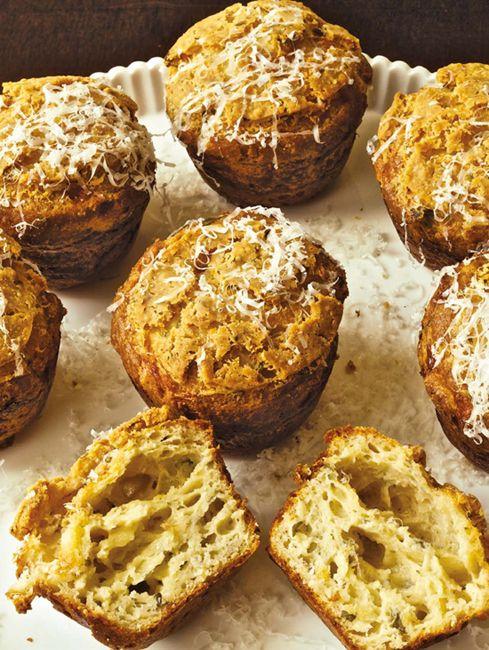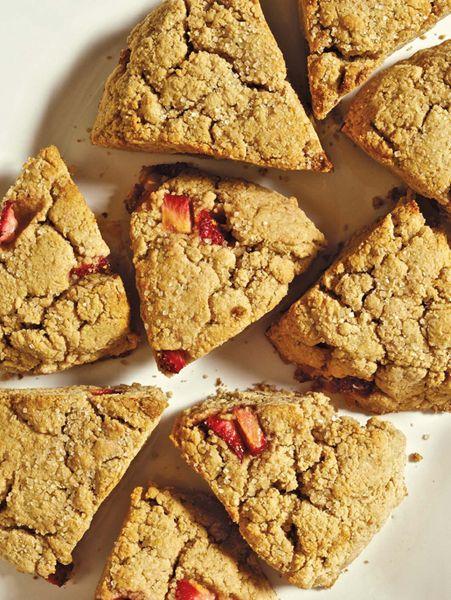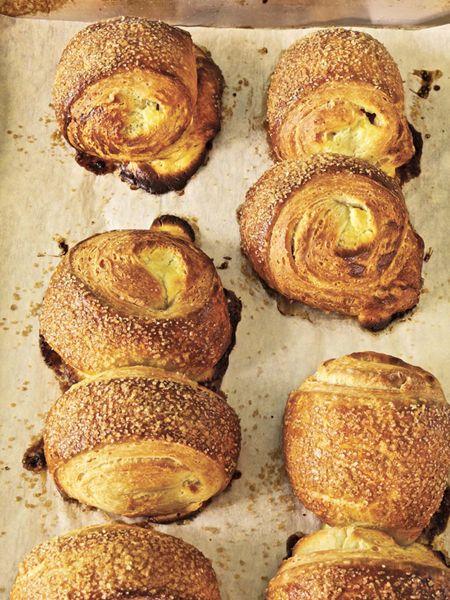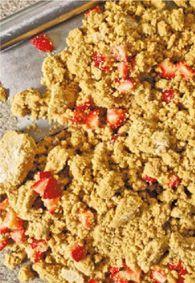Maximum Flavor: Recipes That Will Change the Way You Cook (6 page)
Read Maximum Flavor: Recipes That Will Change the Way You Cook Online
Authors: Aki Kamozawa,H. Alexander Talbot
Tags: #Cooking, #Reference, #Courses & Dishes, #General, #Methods

MAKE THE CHOUX PASTE:
In a medium saucepan, combine the milk, garlic butter, and salt. Bring to a simmer over medium-high heat. Add the flours and stir until the dough forms a ball, pulling away from the edges and forming a light film on the bottom of the pan, 2 to 3 minutes. Transfer the dough to a stand mixer fitted with the paddle attachment. Mix the dough on medium-low for 5 minutes until it cools, and then start adding the eggs one at a time, allowing each one to be absorbed into the dough before adding the next. Add the cheese and mix until just combined. Turn off the mixer and set the bowl in an ice water bath for about 30 minutes until the dough is cool. Refrigerate it overnight in a covered container.
MAKE THE CHEESE TOPPING:
In a medium bowl, stir together the flour, cheese, and salt. Use a rubber spatula to stir in the melted garlic butter. Transfer the cheese dough to a sheet of parchment paper and cover with another piece of parchment paper. Use a rolling pin to roll the dough out to a thickness of ¹/
8
inch (3 mm). Put the rolled-out dough onto a baking sheet and put it in the freezer. Let it freeze completely, about 45 minutes.
Remove the dough from the freezer and remove the top layer of parchment. Use a 1.5-inch (4 cm) round cutter to punch out the dough, making 24 pieces. Transfer the dough rounds to a plate, cover them with plastic wrap, and put in the refrigerator. The dough trimmings may be brought back to room temperature and rolled again one time if necessary.
Preheat the oven to 425°F (218°C).
Scoop ½ cup (100 grams) of choux paste into each cup of a standard-size nonstick muffin tin. You will need two pans if you are baking them all at once. Put one round of cheese topping on top of each scoop of dough and press it down to make sure it is centered and level. Put the popovers into the oven and bake for 15 minutes.
Rotate the pan, decrease the oven temperature to 350°F (180°C), and bake until they are fully puffed and golden brown, 30 minutes more. Remove the pan from the oven, turn the popovers out of the pan, and let them cool on a wire rack for 5 minutes. Use a rasp-style grater to grate cheese over the tops. Serve hot.
CHOUX PASTE is a classic French dough, most commonly associated with pastries like cream puffs and éclairs. It is a classic example of steam leavening, where the high water content of the dough causes it to puff dramatically in the oven before the proteins in the flour and the eggs set around the hollow center. It has a light, crispy exterior and a moist, tender interior. As long as you cook it long enough in the initial mixing process, you almost can’t go wrong with it. In addition to baking, choux paste is often deep-fried into doughnuts, as with Mexican
churros
, for an incredibly crispy outside and a light as air crumb.
GARLIC BUTTER
MAKES ABOUT 10.5 OUNCES (21 TABLESPOONS) / 300 GRAMS
6
garlic
cloves
10 ounces 283 grams
unsalted butter,
diced
½ cup 12 grams chopped fresh
parsley
Peel the garlic and use a mandoline to thinly slice it, discarding the ends. Put the garlic slices and butter in a small saucepan. Put over medium heat to melt the butter, and continue to cook until the garlic is just softened, 3 to 5 minutes. Add the parsley and cook until it becomes bright green and fragrant, 1 to 2 minutes. Remove the pan from the heat and transfer the mixture to a heatproof container. Let cool, uncovered, for 30 minutes, then cover and refrigerate for up to 2 weeks.


NUT BUTTER SCONES
WE DEVELOPED THIS VERSATILE RECIPE WHEN WE WERE
running a small hotel in Colorado. Every morning we served breakfast. We wanted to be able to make great baked goods for everyone who stayed with us. These scones can be made to suit almost any dietary strictures, even gluten-free if you substitute one of our
gluten-free blends
for the flours. And they are delicious. One of our favorite variations is the combination of peanut butter and fresh strawberries. The process of mixing them in the food processor yields a very tender scone, light as a feather and practically melting in your mouth. It was one of the recipes our guests requested most. If you like a little more structure to your scones, just knead the dough a few times before folding in the fruit. It’s that easy to change.
MAKES 12 SMALL SCONES
1½ cups 225 grams
all-purpose flour
1½ cups 210 grams
white whole wheat flour
½ cup 100 grams
granulated
sugar
2 teaspoons 12 grams
baking powder
½ teaspoon 2.5 grams
baking soda
½ teaspoon 3 grams
fine sea salt
1 cup 270 grams
nut butter
(peanut, cashew, almond, etc.), cold
1 cup 260 grams
whole milk
(or substitute soy, almond, or rice milk)
¾ cup
fruit
(berries, raisins, diced bananas, etc.)
2 tablespoons 25 grams
raw sugar
Preheat the oven to 400˚F (205°C). Line a baking sheet with parchment paper.
In a food processor, combine the flours, granulated sugar, baking powder, baking soda, and salt and pulse a few times to blend. Add the nut butter and pulse to blend. The mixture should look coarse and granular. Add ¾ cup (195 grams) of the milk and pulse until the mixture begins to clump together. If it seems too dry, add the remaining milk, 2 tablespoons (32.5 grams) at a time, pulsing in between additions, until it begins to clump together and look like coarse streusel.
Turn the dough out onto a lightly floured countertop and scatter the fruit over the top. Use your hands and a bench scraper, if you have one, to gently fold the fruit into the dough, adding a bit of flour if the juices from the fruit make the dough too wet to hold together. It should just hold when you press the dough together. Form the dough into an 8-inch (20 cm) round and cut it into 12 equal wedges. Or you can shape it into two 4-inch (10 cm) rounds and cut each into 6 pieces.
Put the scones on the baking sheet. Sprinkle the tops with the raw sugar. Bake for 8 minutes, rotate the sheet, and bake until golden brown, 4 to 8 minutes more, checking after 4 minutes. Let the scones cool on the baking sheet for 5 minutes before serving.

NO-KNEAD DANISH
DANISH DOUGH IS THE BEST POSSIBLE HYBRID OF PIE DOUGH
and yeasted dough, because it combines the crispness and flakiness of butter pie dough with the softness and flavor of a slow-fermented yeast dough. It is traditionally made using a technique known as lamination. Typically, to make a lamination, you take yeasted dough and a butter block, wrap the dough around the butter, and then carefully fold it to create several hundred layers. When you bake the dough it becomes incredibly light and flaky from the combination of yeast and steam leavening. The action of the yeast makes the dough rise as it bakes, while the steam leavening that occurs when water evaporates out of the butter creates the honeycomb structure that is the hallmark of laminated pastries.
This version takes a different approach. We cut the butter into the flour mixture as we would for pie dough, and keep the traditional turns, or folding, of the dough in order to create layers of butter and flour in the finished dough. It’s a little less finicky than the original, and the long fermentation ensures a great yeasty flavor in the finished Danish.
MAKES 16 PASTRIES
DOUGH
4⅔ cups 700 grams
all-purpose flour
12 ounces 340 grams cold
unsalted butter,
cut into slices
1¼ teaspoons 3.5 grams
instant yeast
6½ tablespoons 80 grams
sugar
2½ teaspoons 15 grams
fine sea salt
1½ cups 405 grams
whole milk,
at room temperature
2 large
eggs,
at room temperature
2 tablespoons 28 grams
unsalted butter,
melted and cooled
FILLING
8 ounces 225 grams
cream cheese
¼ cup 50 grams
sugar
1 large
egg yolk
Very scant ¼ teaspoon 1 gram
fine sea salt
⅛ teaspoon 0.25 gram
ground mace
3 tablespoons 45 grams
crème fraîche
,
homemade or store-bought, or heavy cream
2 large
egg yolks
¼ cup 50 grams
raw sugar
MAKE THE DOUGH:
Put 2 cups (300 grams) of the flour in a food processor and add the butter. Pulse until the butter and flour become evenly combined into a coarse, slightly chunky meal.
Put the remaining 2⅔ cups (400 grams) of flour in a large bowl. Add the yeast, sugar, and salt to the bowl and whisk together. Stir the butter-flour mixture into the dry ingredients. In a separate medium bowl, whisk together the milk, eggs, and melted butter. Pour the wet ingredients into the bowl of dry ingredients and use a wooden spoon to stir the mixture until it is completely combined into a damp, shaggy ball. Cover the bowl with plastic wrap and let the dough rest at a warm room temperature of 70°F (21°C) for 8 hours. Have faith at this point; it will come together nicely as it rises.
Uncover the bowl and use a rubber spatula to gently loosen the dough from the bowl. Dampen your hands with cool water and slide one hand under one side of the dough. Fold that side of the dough into the center and press it down gently so it adheres to itself. Give the bowl a quarter turn and repeat the folding process two more times. After the fourth fold, flip the dough over so the seams are on the bottom. Cover the bowl with plastic wrap and let the dough rise at room temperature for 10 to 12 hours. (We usually let it go overnight.)
After the dough has risen, repeat the 4 folds from the previous step, and then transfer the dough to a large parchment paper–lined baking sheet. Gently press the dough out on the parchment paper so that it is almost the same size as the pan. Cover the dough with plastic wrap and refrigerate for 3 hours.

